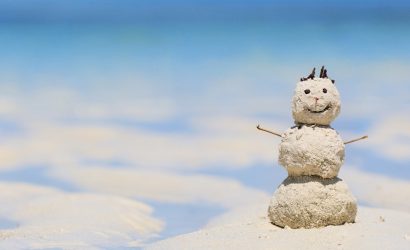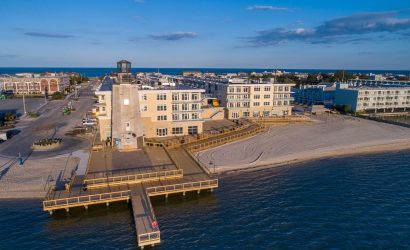The Native Americans that once inhabited the fields, marshlands, and forests of the Eastern Shore may be long gone, but they are not forgotten. With totem poles, teepees, research centers, and museums throughout the area in remembrance, the authentic and original settlers of this land will remain a large part of local history. Here are a few icons of Native American history:
Ocean City Totem Pole
The 25-foot hand-chiseled totem pole that stands watching over the incoming ships, tourists, and fisherman at Inlet Park in downtown Ocean City was a gift to the State of Maryland. The carving, completed in 1976, represents an Assateague Indian. The Assateague Indians called the shores of Maryland and Virginia home until the mid-1700’s.
The Native Americans were generally a friendly tribe, until the European settlers docked their ships off of Assateague’s coast and tried to make the natives give up their land. The Assateauges did not like the idea of giving their land, that was the perfect place for crabbing, hunting, fowling, and fishing, to never-before-seen and unfamiliar men. The land ownership conflicts resulted in the 1662 Maryland Treaty and the disappearance of every tribe member as well as a new European settlement.
World-famous artist, Peter Toth, created 50 totem poles – one in each state – to promote unity among all people. The carving of the Assateague Indian was placed in the Inlet Park as a tribute to the Native American Culture that once thrived in Ocean City.
|
 |
|
Bethany Beach Totem Pole
Just like the Ocean City Totem Pole, the Bethany Beach pole was carved by a Hungarian immigrant, Peter Toth. The artist had been very interested in Native North American culture and history and donated one of his works to the State of Delaware. The 24-foot totem pole honors the Nanticoke Indian tribe.
Since 1976, the giant depiction of Chief Little Owl has been exposed to the elements. The piece has been resurrected twice since the first installation. Toth’s original sculpture was weakened by termites and blown over by strong winds in 1992. After the storm, a sculptor, Dennis Beech, installed a new Nanticoke carving meant to mimic the original piece. Once again, due to pesky termites and coastal storms, the wooden sculpture decayed. In 2002, Charlie Clark, a descendent of Little Owl, blessed a new red cedar carving. With Clark’s blessing, that included a traditional tribal song, prayer and tobacco ritual, a new carving by Toth was erected. Bethany Beach’s original totem pole remnants can be found at the Nanticoke Indian Center in Millsboro, DE.
The giant sculpture welcomes thousands of visitors to Bethany Beach each year. It is an icon of the coastal town and a way to remember the native heritage of the first inhabitant of the seaside community.
|
 |
Fort Whaley Campground
While driving towards Ocean City on Route 50 from western points, travelers may have noticed a pair of teepees nestled in a grassy light under a giant sign that reads, “Fort Whaley Campground”. The campground, open from March – November, tells the story of settlers, Native Americans, and cowboys of the west.
Fort Whaley Campground in Whaleyville, MD is a sister to Frontier Town in West Ocean City. The campgrounds put on a Wild West Show that explains how Native Americans from the east would travel roughly 60-miles in a 15-hour day to head west where the land was still unclaimed territory and European settlers were nowhere to be found.
The teepees outside of the campground are a quite the site. Although local Indian tribes built wigwams to shelter their belongings and themselves from Eastern Shore weather, the teepees are an icon of Native American tradition. Campers can sleep in teepees or wigwams of other sorts at Fort Whaley – tents. A primitive pitched tent can be set up at the campground for only $22 per night.
|
 |
Edward H. Nabb Research Center for Delmarva History & Culture
On the Salisbury University campus there is a building where you can find ancient arrowheads, grinding rocks, hand sculpted pots, and other tools used by local Native Americans. The Edward H. Nabb Research Center for Delmarva History and Culture collects, preserves, and archives historic materials. The shelves and storage rooms of the center are stocked with information that let visitors take a peek at the past.
The staff at the Nabb Center is very helping and eager to spread the word about all they can offer. There is a section throughout the center dedicated just Native American settlements. From 1663 – 1759, tribes inhabited the neck of land just south of the Wicomico River in Somerset County, MD. This area is currently known as Salisbury. In 1608, Captain John Smith explored the Chesapeake Bay. In 1622, many colonies went extinct after the spread of disease and colonial massacres.
The center is one the best Native American history archives in the state and it’s located in Salisbury. Many Salisbury University students, professors, and faculty members frequent the history and culture libraries to determine their genealogy, local history, or piece together fragments of yesteryears.
|
 |
Native American Museum
The Nanticoke Native Americans were known as the ‘tidewater people’ or ‘the people of the tidewaters’. It makes sense – they occupied areas along the water of the Chesapeake Bay and the Atlantic Ocean. The same area many call ‘home’ today was once home to nearly 200 warriors.
At the Native American Museum, off of Route 24 in Millsboro, DE, there are showcases filled with tools – arrowheads, stones, pottery, axe hammers, and more – that were once used to cultivate local land. The beautiful waterways, hills, valleys, and scenery of the Eastern Shore were greatly appreciated by the Nanticoke tribe.
The Nanticoke Indian Center is utilized for regular monthly tribal meetings and is open to members for family dinners or gatherings. It is also open for church and community events and youth group meetings and practices by reservation. The Native American Museum has seasonal hours. The museum in open for free tours: Tuesday – Saturday from 10 am – 4 pm and on Sunday from 12 – 4 pm.
|
 |
Photos by Ami Reist.









